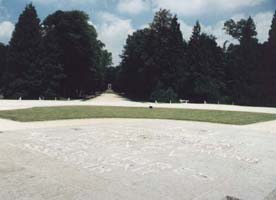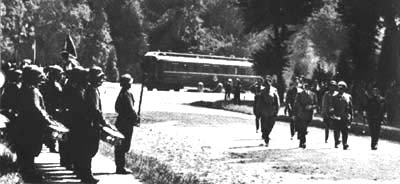IN THE FOREST OF COMPIEGNE
NOVEMBER 1918 - THE ALLIED TRIUMPH
At 5:10 am, 11 November 1918, the representatives of the German high
command signed the armistice dictated to them by Marshal Foch, Supreme
Commander of the Allied Forces. Six hours later at the 11th hour of the
11th day of the 11th month of 1918 World War I ended. The Third Republic,
the most enduring French regime since the Revolution, had with the help of
its democratic allies, the British Empire and the United States of America,
survived it strongest challenge. The old order, established after
Napoleon's defeat at Waterloo, had vanished. The Germans who arrived in the
Forest of Compiegne as representatives of the German Empire signed the
armistice three days later as representatives of the German Republic. The
empires of the Hapsburgs, Hohenzollerns, Romanovs and Ottomans were no
more. Establishing a new order proved more difficult, perhaps, than anyone
present in Wagon Lits Company coach No. 2419D on that misty morning might
have imagined.
Where better to begin an exploration of the history,
politics and emotions of the brief period between the World Wars than in
the Forest of Compiegne? Here, amidst the memorials symbolic of the
unresolved bitterness of both victors and vanquished, the short interval
between peace and war would begin and end.
THE GLADE OF THE ARMISTICE
No time was wasted in turning the historic meeting place into a
national shrine and memorial to the victory of French arms. On the
initiative of M. Fournier, Mayor of Compiegne, the wooded bog was
transformed into "The Glade of the Armistice". A boulevard, 250 feet wide,
was opened up between the Compiegne-Rethondes road and the railroad. A
circular clearing, 100 yards in diameter, was carved from the woods and at
its center was placed a stone slab bearing the words of Binet-Valmer:
|
ICI
LE 11 NOVEMBER 1918
SVCCOMBA
LE CRIMINEL ORGVEIL
DE L'EMPIRE ALLEMAND
VAINCV
PAR LES
PEVPLES LIBRES
OV IL PRETENDAIT
ASSERVIR
"Here, 11 November 1918, succumbed the criminal pride of the German Empire.
Vanquished by the free peoples it sought to enslave." |

|
Granite slabs marked
the exact positions of the cars used by Marshal Foch and the German
plenipotentiaries. Le Matin, a Paris newspaper, raised funds from its
subscribers for a memorial to the liberators of Alsace and Lorraine which
was placed at the far end of the boulevard. The bronze sculpture of a sword
striking down the Imperial Eagle of Germany is framed by Alsatian sandstone
and inscribed "To the heroic soldiers of France - Defender of Fatherland
and of Right - Glorious liberators of Alsace and Lorraine". The Glade was
formally dedicated on Armistice Day 1922 by Presidents Alexandre Millerand
and Raymond Poincare.
Marshal Foch's coach, Wagon Lits Company car No. 2419D, was returned
to its former service as a dining car after the war. It was exhibited in
the courtyard of Les Invalides in Paris from 1921 to 1927. The "Wagon"
returned to the Glade on Armistice Day 1927 when it was installed in a
shelter built by the city of Compiegne with funds contributed by American,
Henry Fleming. Marshal Foch and General Weygand returned to the clearing
for the ceremony.
The last of the Glade's memorials, a statue of Marshal Foch by
Michelet, was dedicated in the fall of 1937 by General Georges, the
Minister of War, in the presence of the Marshal's widow, Madame Foch, and
General Weygand. The clouds of war gathered once more about the Glade and
the Marshal's work would soon be in jeopardy.
JUNE 1940 - THE DEBACLE
World War II on the western front began in earnest on the morning of
May 10, 1940. Once more Germany would attack its neighbor through the
neutral low countries and this time there would be no Miracle on the Marne.
Within six weeks the British Expeditionary Force was pushed back across the
Channel. France, the last surviving democracy on the continent, was forced
to sue for peace.
On June 17th the panic stricken government, formed by Marshal Petain,
made a formal request for an armistice. Three days later a delegation led
by General Huntziger left Bordeaux at 2pm intending to rendevous with the
Germans at the Loire bridge in Tours at 5pm. After battling against the
tide of retreating troops and refugees the envoys finally reached the river
at 10pm. There they were directed to continue on to Chartres. Several of
their number suspected that the Germans would hold the talks in the Palace
of Versailles where the King of Prussia had been enthroned as Kaiser of a
united German Empire in 1871 and where the humiliating Peace Treaty had
been forced on Germany in 1919. The party continued on to Paris and spent
the night before being directed to their final destination.
In Bordeaux the commander of the French forces, General Weygand, waited
anxiously for news of the delegation. At 8:30 pm, June 21, 1940 his phone
finally rang: Huntziger, "I'm in the Wagon"; Weygand, "mon pauvre ami". The
shock and recognition were instantaneous. German engineers had demolished
the front wall of the museum and moved the car on to the track and placed
it exactly were it had stood 22 years before when Weygand had read Foch's
terms to the representatives of a defeated Germany.
The arrival of the German Chancellor as described by William L. Shirer
in The Collapse of the Third Republic: "Adolf Hitler, at the moment of his
greatest triumph, was in a truculent and arrogant mood as he arrived at the
little clearing in the woods at Rethondes at 3:15 pm on June 21. To dictate
an armistice in this historic place was sweet revenge for the man who had
been a lowly corporal in the army that had been forced to give up in 1918,
and he did not hide his feelings. Standing a few feet away, I saw his face
light up, successively, with hate, scorn, revenge, triumph as he strode to
the little marble block that marked the spot where Foch's wagonlit had
stood in 1918." General Keitel read a declaration written by Hitler
explaining why this place had been chosen for the talks, "to efface once
and for all by an act of reparative justice a memory which was resented by
the German people as the greatest shame of all time."

DESTRUCTION OF THE GLADE
Three days after the signing of the second armistice the stone slab
whose inscription had so offended Hitler was broken up and packed off to
Germany in wooden crates. The Alsace Lorraine memorial suffered the same
fate. The Wagon was hauled to Berlin where the new victors placed it on
exhibit until 1943. The Glade's avenues and clearance were plowed up, its
trees cut down and the remains of the shed demolished. Only the statue of
Foch remained unviolated. An act of soldierly courtesy on the part of the
Germans? No, more likely another bit of petty revenge on the part of the
Fueher; the victor of 1918 left in solitude to contemplate the annihilation
of his work.
SUMMER 1944 - LIBERATION
France had lost a battle but France had not lost a war.
Compiegne was liberated by American and French troops on September 1,
1944. A short time there after German POWs were put to work restoring the
Armistice Glade. On the afternoon of October 21,1944 the Citizens of
Compiegne gathered in the Glade for a meeting of atonement. A wooden
substitute covered in a memorial clothe was placed on the spot were the
sacred stone formerly lay. The mayor of Compiegne had directed the town
architect to secretly make these objects during the occupation. On
Armistice Day 1944. at 5:15 pm the Prime Minister M. Jeanneney took a torch
and lit a stake at the foot of the wooden slab while scouts piled bundles
of kindling around it. The Glade was purified.
THE AFTERMATH
The massive aerial bombardment of Berlin became so intense by 1943
that the Nazi regime decided that if its most prize spoil of war was to be
protected it would have to be removed from the capital. Marshal Foch's
wagon-lit was moved to the forest of Thuringia. In April 1945 with the
allies driving deep into the German homeland, SS troops committed one last
act of vengeance against the victors of 1918 by setting fire to the
historic coach.
Germany surrendered once more on May 8, 1945. This time in a
schoolhouse in Reims. A short time there after the crates containing the
pieces of the sacred stone slab and Alsace Lorraine monuments were located
in Berlin. They were restored and returned to their original locations in
the Armistice Clearing. Visitors once again flocked to the historic Glade
at Compiegne but still yearned to see the old wagon. Another wagon, car
No.2439 D constructed in 1913 like the original was placed on exhibit in a
new shed. Fortunately, the original furnishings and documents from the
Marshal's wagon were removed for safe keeping at the outbreak of World War
II in 1939. The dedication of the Museum of the Armistice on November 11,
1950 marked the full restoration of the Glade to its pre-1940 condition.
Visit the Glade... (7 pictures, ca. 160k)
Contributed by Richard Doody
|


